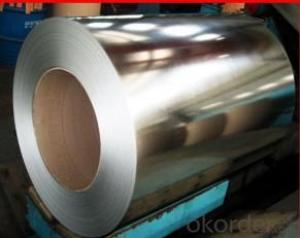Hot Dipped Galvanized Steel Coil/GT00818
- Loading Port:
- Shanghai
- Payment Terms:
- TT OR LC
- Min Order Qty:
- 30 m.t.
- Supply Capability:
- 10000 m.t./month
OKorder Service Pledge
OKorder Financial Service
You Might Also Like
Basic Info.
Model NO.:GT00818
Surface Treatment:Galvanized
Additional Info.
Packing:At buyer′s requirement
Standard:GB,JIS,ASTM
Origin:CHINA
HS Code:72123000
Production Capacity:50,000 mt/year
Product Description
Commodity: Hot dipped galvanized steel coil
Size: Thickness: 0.20mm to 1.2mm; Width: 500mm to 820mm
Surface finish: Regular spangle; Small spangle
Surface treatment: Chromated passivation
Zinc coating: Z08, Z12, Z18
Packing: Mill's standard packing for exporting
Usage: used in the industries such as construction ,cold rolling forming and electro mechanics manufacturing, household electric appliance manufacturing and etc
Standard adopted: GB/T2518-1998;Also we supply such steel strips according to JIS,ASTM standard to meet users'requirements.
Steel grade: Q195,Q195L,SPCC(Other material require agreement )
Equivalent standard: JIS G3302 1998 or ASTM A653M/A924M 1998
Price Terms: FOB, CIF Term
Payment Terms: T/T, L/C at sight
Delivery: 15 days after receiving your valid L/C/down payment
- Q:I'm in the middle of a remodel and buying appliances. Is there any way to ensure that the stainless steel is the same tone if you get different brands?
- Stainless steel is pretty much stainless steel. The differences in tone you can get is when you get stainless steel look appliances. They tend to be a bit more like a charcoal color than true stainless steel color. When I bought my house, it had a stainless steel GE microwave, dishwasher, and stove, and a Braun stainless steel range hood. When we remodeled last year, we got a Maytag Ice20 stainless steel refrigerator and a Kholer stainless steel sink. They all look fine together.
- Q:What are the different methods of surface cleaning for steel coils?
- Some of the different methods of surface cleaning for steel coils include mechanical cleaning, chemical cleaning, and high-pressure water cleaning. Mechanical cleaning involves using abrasive materials, such as brushes or sandpaper, to physically remove dirt, rust, or other contaminants from the surface of the steel coils. Chemical cleaning involves the use of specific cleaning agents or solvents to dissolve or loosen dirt and contaminants from the surface. High-pressure water cleaning utilizes a powerful jet of water to remove dirt and debris from the steel coils. These methods can be used individually or in combination depending on the specific cleaning requirements and condition of the steel coils.
- Q:Can steel coils be coated with anti-glare materials?
- Yes, steel coils can be coated with anti-glare materials.
- Q:How are steel coils used in the production of industrial tanks?
- Steel coils are used in the production of industrial tanks as they are rolled and shaped into the desired form, providing the necessary strength and durability for the tank structure.
- Q:What are the common sizes of steel coils used in the industry?
- The common sizes of steel coils used in the industry vary depending on the specific application and requirements. However, some commonly used sizes include widths ranging from 24 to 72 inches and thicknesses ranging from 0.010 to 0.250 inches.
- Q:Can steel coils be coated with zinc-nickel alloy?
- Yes, steel coils can be coated with zinc-nickel alloy. This coating provides excellent corrosion resistance and durability to the steel coils, making them suitable for various applications in industries such as automotive, construction, and manufacturing.
- Q:What are the common tests performed on steel coils?
- The common tests performed on steel coils include dimensional inspection, visual inspection, tensile testing, hardness testing, bend testing, and surface quality assessment. These tests ensure the quality, strength, and integrity of the steel coils before their use in various applications such as construction, automotive, and manufacturing.
- Q:How are steel coils inspected for camber using laser profiling?
- Steel coils are inspected for camber using laser profiling by passing the coil through a laser scanning system. The laser scans the surface of the coil, measuring the height variations across its width and length. The data collected by the laser is analyzed to determine any camber or curvature deviations in the coil. This method provides a quick and accurate way to identify and measure camber in steel coils.
- Q:How are steel coils used in the production of shipbuilding components?
- Steel coils are used in the production of shipbuilding components as they provide a strong and durable material for constructing various parts of ships such as hulls, decks, and bulkheads. These coils are processed and shaped into required forms, ensuring the structural integrity and stability of the ship.
1. Manufacturer Overview |
|
|---|---|
| Location | |
| Year Established | |
| Annual Output Value | |
| Main Markets | |
| Company Certifications | |
2. Manufacturer Certificates |
|
|---|---|
| a) Certification Name | |
| Range | |
| Reference | |
| Validity Period | |
3. Manufacturer Capability |
|
|---|---|
| a)Trade Capacity | |
| Nearest Port | |
| Export Percentage | |
| No.of Employees in Trade Department | |
| Language Spoken: | |
| b)Factory Information | |
| Factory Size: | |
| No. of Production Lines | |
| Contract Manufacturing | |
| Product Price Range | |
Send your message to us
Hot Dipped Galvanized Steel Coil/GT00818
- Loading Port:
- Shanghai
- Payment Terms:
- TT OR LC
- Min Order Qty:
- 30 m.t.
- Supply Capability:
- 10000 m.t./month
OKorder Service Pledge
OKorder Financial Service
Similar products
New products
Hot products
Related keywords




























